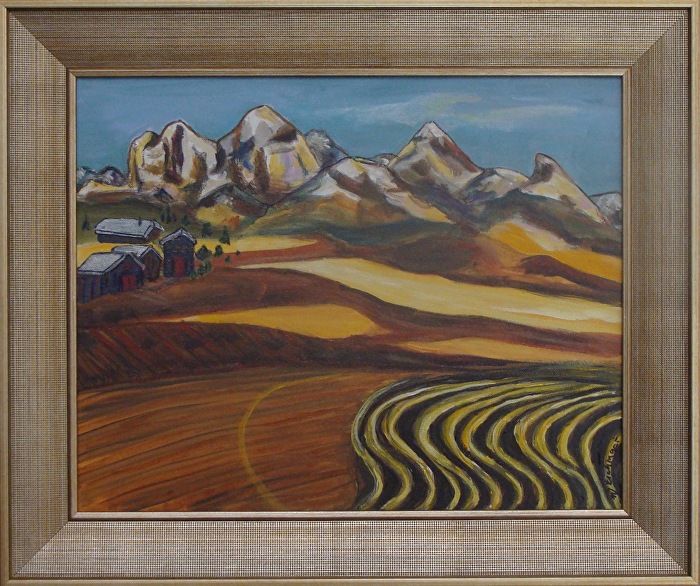
Eastern Oregon Contemplative
Oh give me land lots of land under starry skies above. . . Don’t fence me in.
Let me ride through the wide open country that I love. . . Don’t fence me in.
Let me be by myself in the evening breeze, Listen to the murmur of the cottonwood trees
Send me off to forever but I ask you please. . . Don’t fence me in.
I grew up listening to Gene Autry and Roy Rogers sing “Don’t Fence Me In.” The song was written in 1934 by Cole Porter with lyrics from a poem by Robert Fletcher. It was in the repertoire of many artists including Bing Crosby and Willy Nelson. There’s a yearning in the words, a desire to be left alone to travel with your thoughts. The song is a sad reminder of a bygone era, for there’s hardly a place in the country that isn’t bounded by fences.
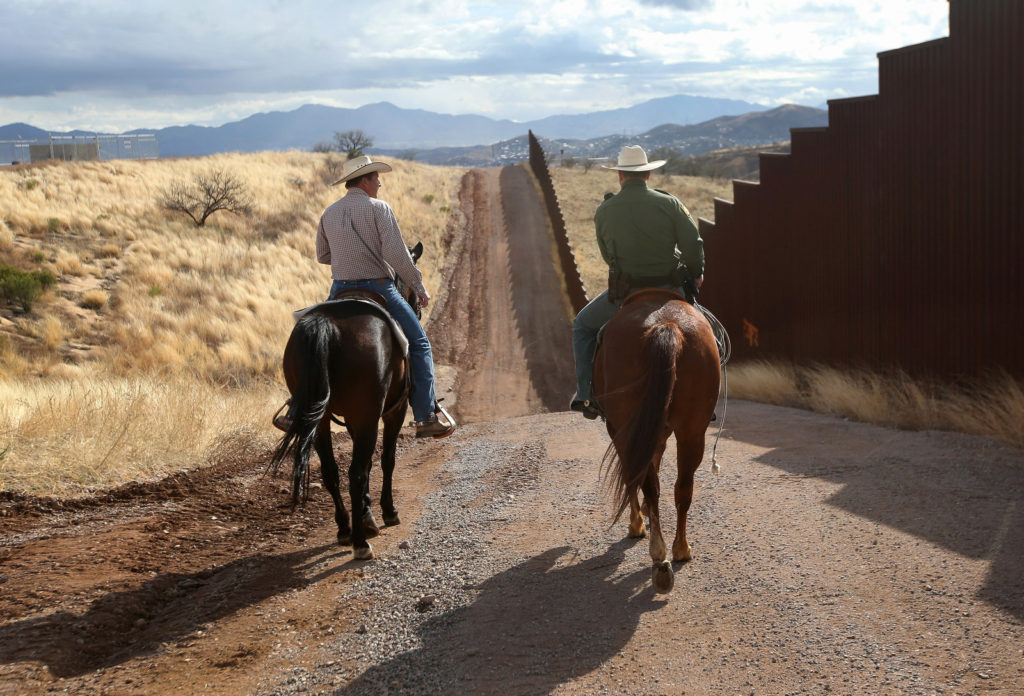
In a push to keep foreigners out, 700 miles of a proposed 1,933 mile fence have been erected on our southern border. Fences crisscross vast areas of fertile prairie lands, high deserts, and the treeless plains.In cities fences isolate people in gated communities to keep undesirables off of private property. Those with money build houses in walled wealthy ghetto areas far away from those living in minority and poor ghetto slums. They purchase ranches in Montana that they enclose with barbed wire fences. The wide open spaces are sprinkled with no trespassing signs and guarded by armed owners.
In poorer neighborhoods, gangs form invisible fences around housing projects and city blocks. Graffiti, a type of no trespassing sign, marks dominance over territory or turf and advertises power. The markings make everyone who live in the neighborhood vulnerable to drive-by shootings by rival gangs. Rich and poor alike, find ways to segregate themselves within boundaries that keep “others” away and reduce their right to roam freely.
Though most Americans were taught otherwise, pre-Columbian Americans did own property. They were primarily farmers, not hunter-gators as was often depicted, with property owned by households, temples or urban nobles. Forests and deserts belonging to an individual or community were regulated common areas where local people could gather wood, berries and game. Iroquois and Algonquian women commonly owned maize fields that many people farmed, collectively distributing the harvest.
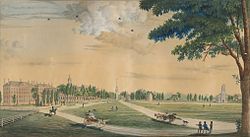
Cambridge Commons in 1808-Harvard College on the left and Christ Church on the right.
Native and colonial clashes occurred when colonists allowed livestock to roam freely and disrupt forest ecosystems that had provided food for Native peoples for generations. In the West, singing cowboys pushed herds of cattle across the land and homesteading farmers destroyed Native hunting, agricultural, and foraging grounds.
Over 50 million buffalo roamed from Mexico to Saskatchewan until the Army promoted hunting them to provide jobs for Civil War veterans, to supply meat for railroad workers, to make it easier to raise cattle, and to eliminate food and material sources for the Indians. By the late seventeenth and early eighteenth centuries fenced in family farms and cattle ranches had taken over the plains.
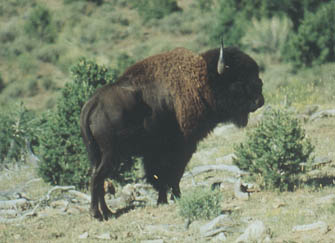
American citizens were told that Indians didn’t have rights to land because they lived nomadically and didn’t own property or have property rights. This falsehood was spread by John Locke and years later endorsed in novels by Ayn Rand and displayed in biased Hollywood movies that focused on the plains Indians whose complex economic and social rules centered on the horse culture.
The Pueblo Indians practiced agriculture and were never nomadic so their households possessed land and owned homes. The Iroquois rotated living quarters among several locations considered best for farming and hunting. Communal property was often possessed by a group or tribe. When it was sold, the chief negotiated rights to the soil.
John Locke’s writings were heeded when he asserted that ownership of land could be obtained by one of three methods;
- Homesteading it via fencing it in, protecting it, and proclaiming that it is under your ownership.
- Acquiring the property title via voluntary transfer.
- Claiming abandoned land by adverse possession: move on it, fence it, mix one’s labor with it, etc.
Adding labor to a parcel of land was all it took to make it yours. Indians had no claims to property because they didn’t improve their land by planting trees or fencing it in to limit its use and preserve value for its owners to sell in the future.
As land use laws in the late 1800s privatized the country amidst those who pushed back to keep some areas available for common use. The National Park Service was started in 1872 when it established Yellowstone National Park in Montana as a “public park or pleasuring – ground for the benefit and enjoyment of the people.” Since then, additional parks and monuments were carved from federal lands, mostly in the West. Today, there are over four hundred parks covering 84 million acres in 50 states and territories. Sadly, these parks are not wide open spaces where we are allowed to roam freely. There is a fee to pay and rules to obey that are set by the Department of the Interior.
Though 331 million people visit the national parks annually, many Americans oppose the idea of preserving public land. Since taking office, President Trump opened up 2 million acres for mining inside national monuments. Last week he finalized plans to open up part of the Arctic National Wildlife Refuge in Alaska to oil and gas development, overturning six decades of protections for the largest remaining stretch of wilderness in the country.
To get away from fenced in properties, gated communities, ghetto areas, and middle class neighborhoods visitors have to make appointments to camp in parks where they are instructed to stay on designated trails when they get there. Though cowboys still sing with gusto about wide open spaces where they’re not fenced in, their yearnings are not heeded.
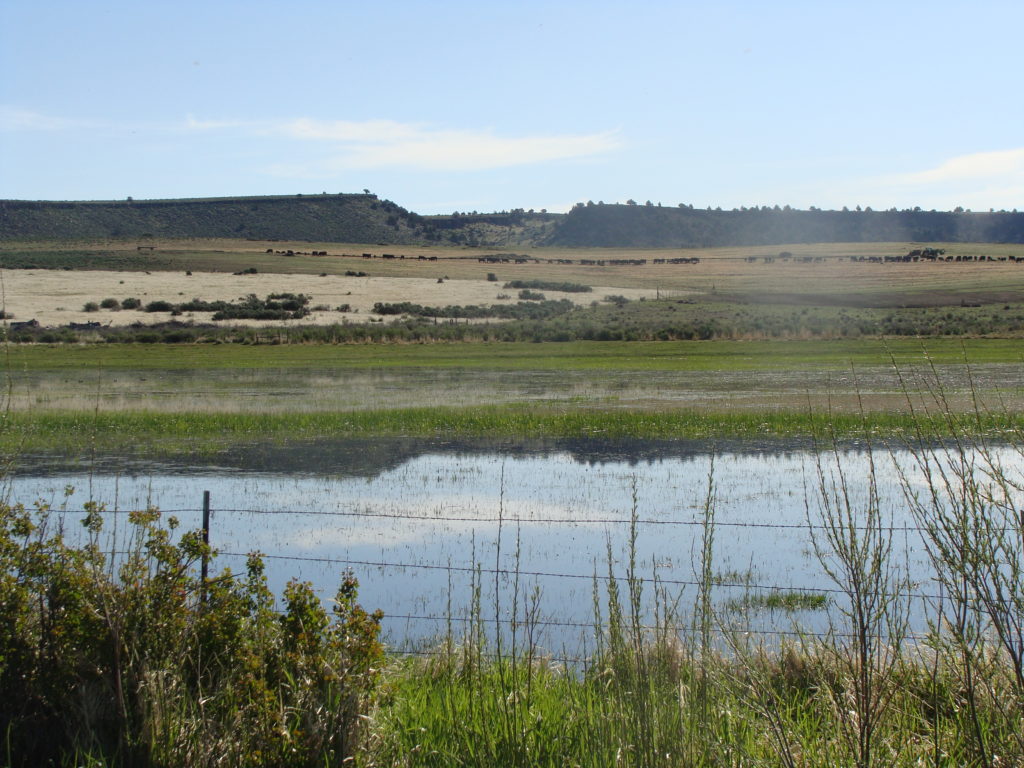
References:
Gershon, Livia, (2019) Yes, Americans Owned Land Before Columbus. JSTOR, Business & Economics. retrieved from https://daily.jstor.org/yes-americans-owned-land-before-columbus/u
McMaken,R (2017) Did the Indians Understand the Concept of Private Property? Mises Institute. retrieved from https://mises.org/wire/did-indians-understand-concept-private-property
Quick History of the National Park Service. National Park Service web site. retrieved from https://www.nps.gov/articles/quick-nps-history.htm
Prentice-Dunn, J. (2018) President Trump opens 2 million acres inside national monuments to mining. Westwise. retrieved from https://medium.com/westwise/president-trump-opens-2-million-acres-inside-national-monuments-to-mining-771917557aa4
Plumer,B & Fountain,H. (2020 ) Trump administration Finalizes Plan to Open Arctic Refuge to drilling. New York TImes. https://www.nytimes.com/2020/08/17/climate/alaska-oil-drilling-anwr.html
Works of Art are always for sale. Eastern Oregon Contemplative / Acrylic on Canvas/ Gold Frame/ 21” by 25” / $ 389
Bunnell,D (2015) Buffalo Holocaust. M. Retrieved from https://medium.com/@davbunnell/once-there-were-50-to-100-million-buffalo-they-were-the-most-numerous-large-mammals-to-ever-exist-e01a5bca9ed8
